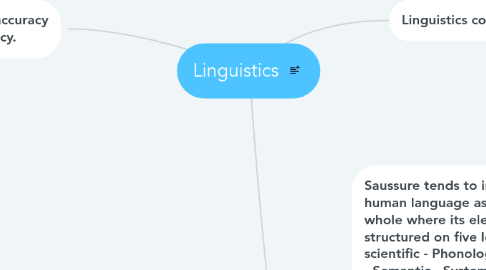Linguistics
by Dalia Rosas

1. Linguistics communication
1.1. It is the fundamental process by which two people (at least) share the same information transmitted (sender) and received (receiver) through a medium (channel). Linguistic communication is a common process that allows the transmission of knwledge, thoughts, ideas, opinons, feelings, attitudes, desires, actions. among other diverse experiences
2. Saussure tends to investigate human language as an organized whole where its elements are structured on five levels: - scientific - Phonological - Syntactic - Semantic - Systematic Since structuralism the question is raised with two budgets: immanentism (the study of an ideal abstraction) and the methodology of systems where the unit of analysis are not the elements considered by themselves but as relationships of interdependence. The characteristics of the structural system of the language are summarized by Benveniste in four points: is a global unit that includes subunits. - A formal balance is established following constant laws. - The constituents of this structure perform a function. - Single-level units are subunits of the top level. The concept of the system was applied with productive performances by the Prague School and the Copenhagen School. But it will be Hjelmslev who reformulates Saussure's ideas deeply and rearranges his vision of language as a system. In his glosmatic theory he replaces the Saussurean concepts of signifier and meaning with those of expression and content. In addition, the structural study, according to Hjelmslev, must be carried out from two planes: that of the expression and that of the content. And these planes contain form and content. In this way, the association of the form of the expression and the form of the content arises a "form between two substances", that is, the language.
2.1. How different systems have been implemented in the language.
3. • Includes aspects of accuracy and grammatical fluency.
3.1. Fluency and accuracy (or correctness) are two fundamental concepts in Didactics Acquisition of Second Languages (ASL). The Common European Framework of Reference for (CEFR) states that these are two components of foreign language communication competence (LE). According to the CEFR, fluidity is one of the components of the functional competence that, together with discursive and organizational competence, is part of the pragmatic competition. The CEFR defines it as "the ability to articulate, to continue go ahead and perform well when you reach a dead end" (p.125), while that in the Dictionary of Key Terms of Spanish as a Foreign Language of the Center Virtual Cervantes fluidity is defined as "the ability to process (both in its reception as in its production) the language - semantic, morphosynical, sociocultural aspects, etc. - with ease and coherence, without excessive pauses or hesitation and at an equal speed or close to that of native speakers." From this point of view, the term of fluidity refers to both verbal fluency (oral and written) and reading fluency. On the other hand, the concept of accuracy, as Housen and Kuiken (2009) point out, considers the most transparent and the oldest. According to the Dictionary of Key Terms Spanish as the foreign language of the Centro Virtual Cervantes, linguistic accuracy concerns "the absence of errors in the use of any of the language skills", and concerns both grammar and other components of the language system (the lexicon, spelling, etc.).


